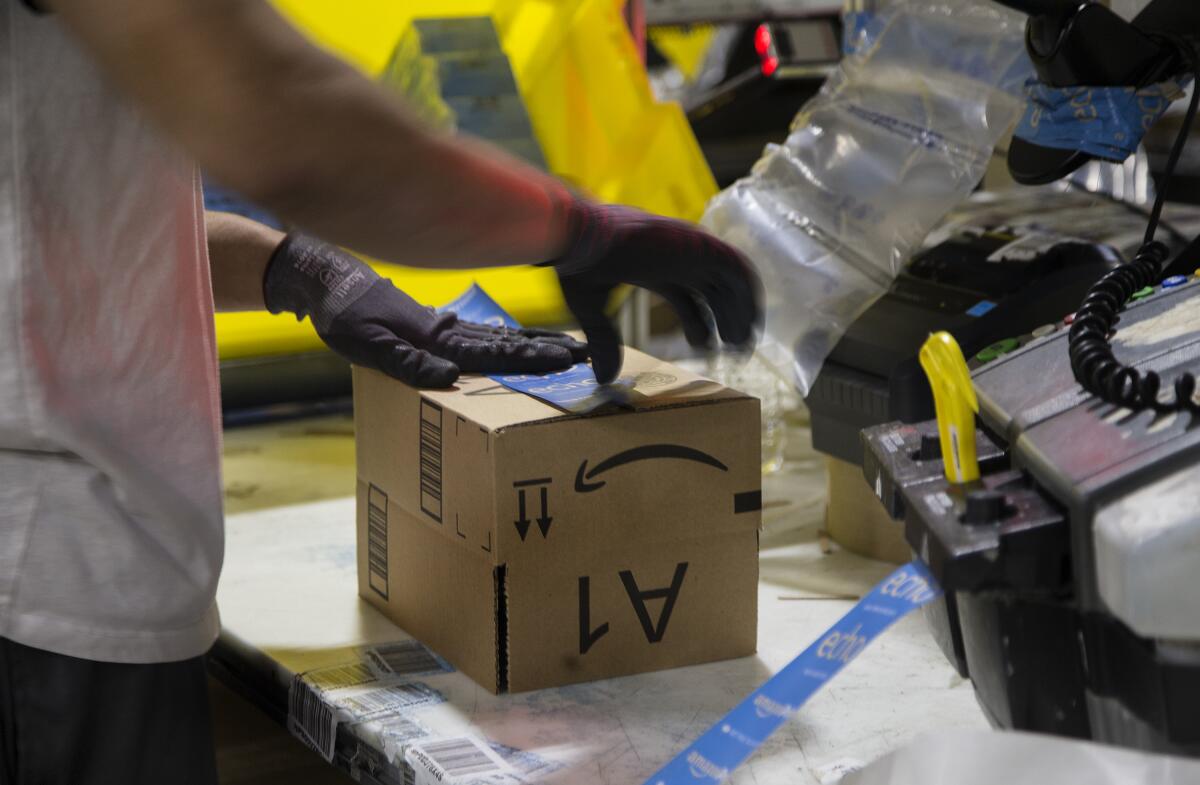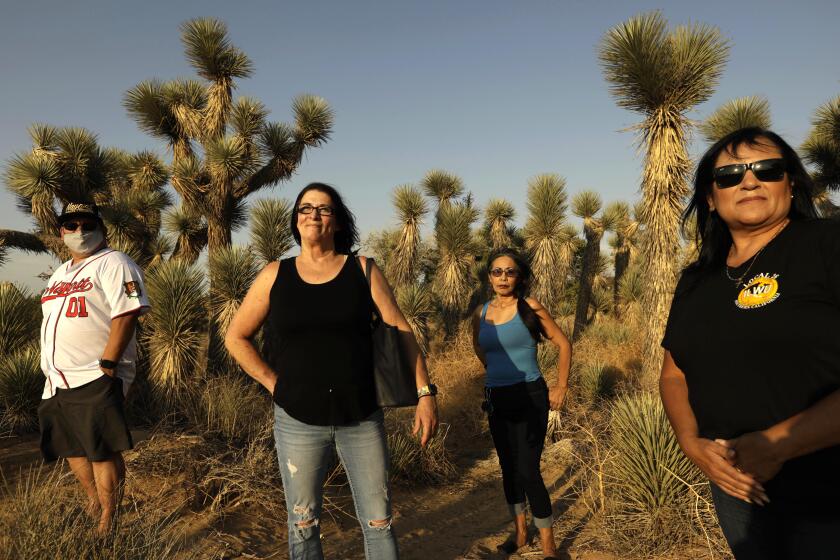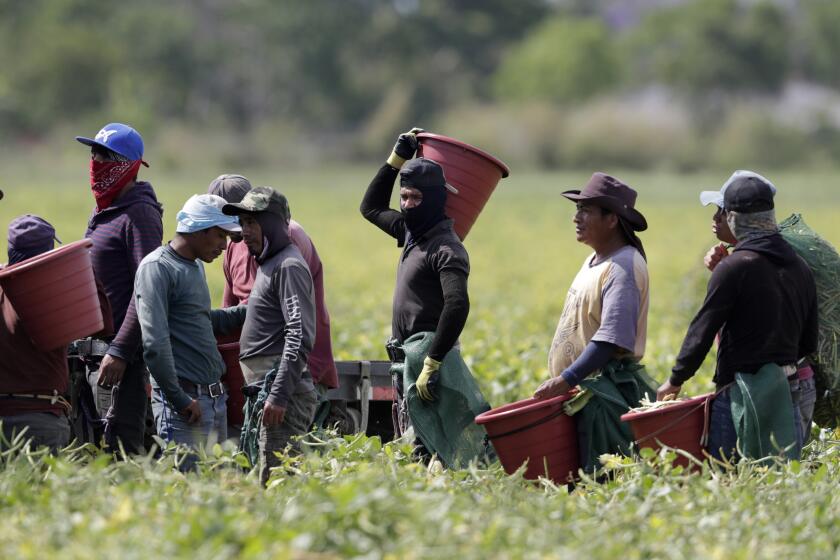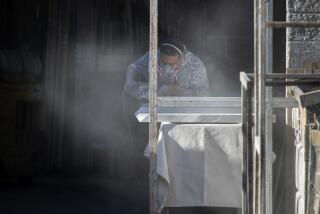Long-awaited California safeguards against hot workplaces delayed again

- Share via
After years of bureaucratic delays, the state board overseeing workplace safety standards was expected Thursday to adopt rules that would require employers to safeguard their workers against excessive heat in indoor workspaces.
Under the proposed rules, employers would have to provide cooling areas and monitor workers taking breaks to cool down for signs of heat illness when temperatures inside reach or surpass 82 degrees. If temperatures climb to 87 degrees, or workers are made to work near hot equipment, employers would be mandated to take additional safety precautions to either cool the broader work site, allocate more breaks, rotate out workers or make other adjustments.
But in the hours before the Department of Industrial Relations’ Occupational Safety & Health Standards board opened its meeting in San Diego, state officials notified board members and labor groups there would be no vote, leaving the heat safety measure once again in limbo.
A Department of Industrial Relations spokesperson said the decision to postpone the vote was made after state finance officials decided more time was needed to analyze the potential financial impact of the proposed rules for addressing indoor heat on public agencies.
“The Department of Industrial Relations and Cal/OSHA remain committed to addressing indoor heat and are evaluating options to strengthen protections as soon as possible. We will continue to educate and protect workers from the impacts of high temperatures,” the spokesperson said in an emailed statement.
Extreme heat is endangering California warehouse workers, who often labor without air conditioning.
Labor leaders and workers pushing for the new standard voiced anger over the delay.
“It’s outrageous that after years of advocacy, on the eve of the vote to finally pass this overdue heat standard, we learned that it was pulled from the agenda with no prior notice or explanation,” said Lorena Gonzalez, head of the California Labor Federation, in a Thursday news release. “It’s shameful that the state of California is turning a blind eye to preventable workplace injuries and deaths.”
Gonzalez said the move meant workers in restaurants, schools, manufacturing, hospitals and warehouses would “continue suffering each day they go without any real, enforceable protections from indoor heat exposure.”
The Department of Industrial Relations spokesperson said the agency will continue investigating potential indoor heat violations under existing regulations such as the state’s injury and illness prevention program, which broadly requires employers to evaluate workplace hazards and unhealthy conditions.
After David Thomas, who chairs the standards board, announced the heat rules had been pulled from the board’s meeting agenda, anger built among workers, union leaders and other labor advocates.
Victor Ramirez, who has worked in various warehouses in the Inland Empire over the past two decades, most recently at a facility in Fontana operated by Menasha Packaging, said many of the warehouses he’s worked in did not have air conditioning or fans. In recent years, fans and air conditioning have become more common, but they “aren’t very effective and those warehouses still feel hot,” he said.
The California Legislature held a hearing about ‘state failures’ regarding farmworker and meatpacking job conditions.
At his current job, where he unloads merchandise packaged by machinery, Ramirez said he often feels like he’s suffocating, his chest hurts and he sweats particularly near forklifts and other equipment that generate heat.
“We need this rule in place right now. Workers need protections, they need training so they know the dangers of the job and working in heat,” Ramirez said. “It’s a basic right to work in a safe environment.”
At one point some attendees at the meeting burst into chants of “What do we want? Heat protections. When do we want it? Now” and “Hey hey, ho ho, corporate greed has got to go.”
Thomas asked San Diego Sheriff’s deputies to step in, and protesters were asked to disperse.
Board members also voiced frustration, saying they said they had been left in the dark about why the vote had been postponed.
Laura Stock, a board member and director of the Labor Occupational Health Program at UC Berkeley, said she was frustrated to learn officials from the Department of Finance had decided at the 11th hour that more time was needed to study the impact of the proposed rules, especially in light of years already spent studying the issue.
“It is clear the public is angry. I and other board members here are equally frustrated at what happened,” Stock said at the meeting. “It undermines the entire process of what we’re doing here.”
In a surprise twist, Thomas, who said he was in favor of the new rules, suggested the standards board should move forward with a vote — if only as a symbolic gesture to signal their dissatisfaction with the Department of Finance’s decision to pull its support for the measure. The six board members unanimously voted to adopt the indoor heat standard.
“We are pleased with the courage of the Standards Board today to do the right thing and vote to protect workers from rising temperatures,” said Sheheryar Kaoosji, executive director of the Warehouse Worker Resource Center, in an emailed statement. “The hottest years on record have occurred in the last ten years. That means the danger of working in high heat has become more acute in the time it has taken to finalize these standards.”
The Department of Finance’s approval of economic impact documents is among the final steps needed before the heat rules can be formally approved and implemented.
The meeting was the latest misstep in a string of mistakes and delays.
In 2006, California became the first state in the nation to implement heat standards for outdoor workers, requiring that employers provide access to shade and water and guarantee the right to take preventive cool-down rests when workers need them. In temperatures of 95 degrees or higher, employers are required to remind workers of safe practices, encourage breaks and drinking of water, and observe them for signs or symptoms of heat illness.
As reports surfaced of brutal conditions affecting warehouse workers’ health, the California Legislature in 2016 directed Cal/OSHA to develop an indoor heat standard by 2019.
Agency staff met the deadline, drafting proposed rules that were based on the existing outdoor heat regulations, but bureaucratic requirements and sluggish movement by various state bodies bogged down the process in subsequent years.
A study of the proposed rules that state law required be done by the Department of Finance, for example, was slowed when two contractors were hired to complete the same assessment — extending the process by at least a year and a half, according to a recent CalMatters report examining the delays.
Cal/OSHA’s standards board did not hold its first public hearing on the indoor heat regulation until May 2023. At that hearing, workers urged the board to swiftly adopt a set of safety rules, but instead the board revised the proposed measures three more times, delaying implementation by another year.
Workers compensation data show that between 2010 and 2018 an average of 185 workers a year claimed injuries from indoor heat, according to a 2021 report by Rand Corp. that analyzed proposed indoor heat rules. In California, 20 workers died from heat illness between 2010 and 2017, seven of them because of indoor heat, the report said.
In recent years, as the state has experienced record-breaking heatwaves, cooks at fast food chains, warehouse workers and delivery drivers have repeatedly raised concerns about high temperatures.
Amid one heatwave in 2022, workers at an Amazon air freight hub in San Bernardino took it upon themselves to document temperatures throughout the facility. Workers recorded indoor temperatures as high as 89 inside the facility, climbing to 96 in cargo planes and tractor trailers.
An Amazon spokeswoman, Mary Kate McCarthy Paradis, at the time called the findings “misleading, or simply inaccurate.”
In July 2023, workers at the hub lodged a formal complaint with Cal/OSHA. In January, Cal/OSHA cited Amazon with a $14,625 penalty for failing to provide adequate water or shade for cool-down breaks. The agency did not cite Amazon for safety violations indoors.
Sara Fee, a former warehouse worker at the San Bernardino facility, said during public comment at the Thursday meeting that she was deeply worried about the impact of delaying implementation of the standard.
“I know that further delay is going to cause injury and death this summer,” Fee said. She urged Cal/OSHA to take action. “Anything you can do to protect workers is needed.”
More to Read
Inside the business of entertainment
The Wide Shot brings you news, analysis and insights on everything from streaming wars to production — and what it all means for the future.
You may occasionally receive promotional content from the Los Angeles Times.













